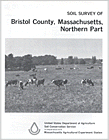Soil Survey of Bristol County, Massachusetts
NORTHERN PART

The following Map Unit Description is from the 1981 Soil Survey of Bristol County, NORTHERN Part. Please note: map unit symbols are DIFFERENT for Bristol North and Bristol South reports, do NOT use these descriptions for Bristol South.
Pe-Pipestone loamy fine sand. This soil is deep, nearly level, and somewhat poorly drained. It is on sandy glacial outwash. Slopes are smooth or very gently undulating and are generally 100 to 400 feet long. The mapped areas are irregular in shape and are from 5 to 25 acres in size.
Typically, the surface layer is friable, black loamy fine sand in the upper 4 inches and loose, mottled grayish brown fine sand in the lower 4 inches. The subsoil extends to a depth of 23 inches, and is friable, dark reddish brown fine sand in the upper 7 inches and loose, mottled, dark yellowish brown fine sand in the lower 8 inches. The substratum to a depth of 60 inches is loose, mottled, light olive brown fine sand.
Included with this soil in mapping are areas of Deerfield, Wareham, and Scarboro soils that are generally less than 3 acres in size. Also included are areas of soil in which the dark reddish brown subsoil is cemented. Included soils make up about 20 percent of the map unit.
Permeability is rapid in the subsoil and very rapid in the substratum, and available water capacity is low. Soil reaction ranges from extremely acid to strongly acid in the upper part of the profile and from very strongly acid to medium acid in the lower part and in the substratum. The root zone extends to a depth of about 20 inches. Root growth is restricted by a seasonal high water table which is at or near the surface 7 to 9 months of the year and by drouthiness in summer and early in fall when the water table drops.
This soil has fair to poor potential for farming. The main farm use is unimproved pasture. The soil has poor potential for urban use and for sanitary waste disposal facilities. It has fair to poor potential for trees and poor potential for wildlife habitat. Most acreage is wooded.
The soil is poorly suited to cultivated crops, hay, and pasture because of the seasonal high water table. The hazard of erosion is slight. The main concern of management is wetness. Conservation management includes providing field drainage, improving tilth, and increasing organic-matter content. Proper stocking rates, deferred grazing, and pasture rotation are pasture management practices that help to maintain desirable plant species.
The seasonal high water table is a major concern in tree productivity. It imposes limitations on equipment use and seedling growth. Important tree species are eastern white pine and red maple.
The seasonal high water table is a limitation for most urban use and for sanitary waste disposal facilities. Rapid percolation is a limitation for sanitary landfills. Capability subclass IVw.